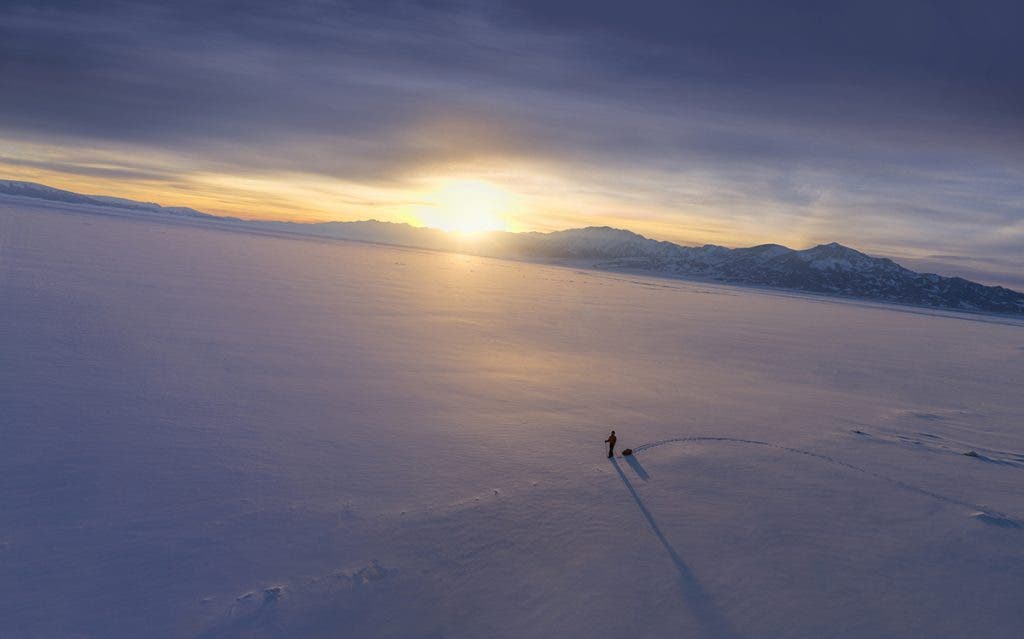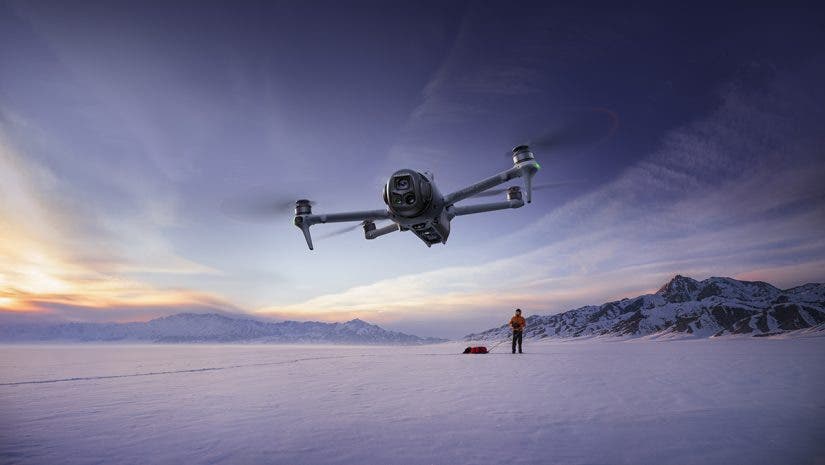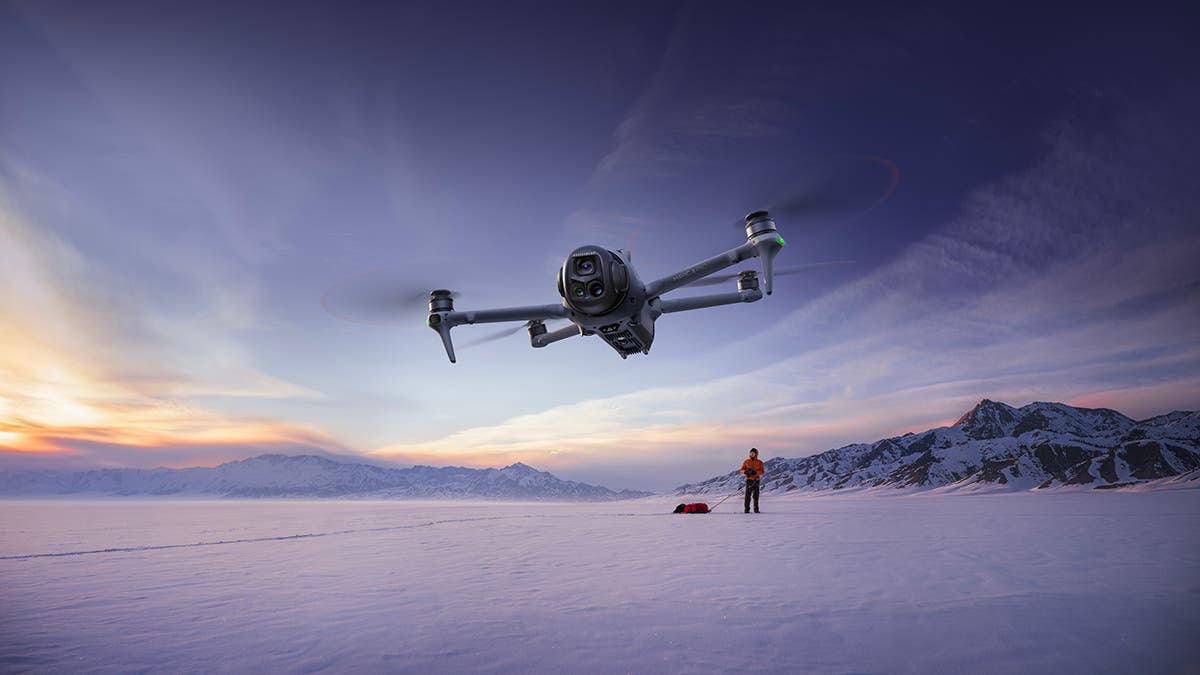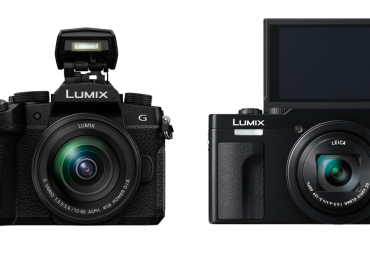DJI has announced a new flagship: the DJI Mavic 4 Pro. This camera drone soars to new heights with a sweeping number of upgrades to improve it over previous models in the lineup. Headlining the updates are a new triple-lens camera system and an upgraded gimbal that offers a full 360 degrees of camera rotation. An optional remote controller adds even more bells and whistles with a bright 7” screen and a built-in microphone. Does it have the right stuff to be the top gun of consumer camera drones?
Key Features
- Triple lens camera system featuring a 4/3 CMOS Hasselblad Main Camera
- “Infinity” gimbal with 360 degrees rotation
- Improved obstacle sensing
- Increased flight time
- Optional collapsible remote controller
What’s New
In a nutshell: more cameras, better cameras, a new gimbal, and improvements across the board. The Mavic 4 Pro ascends above DJI’s prior models with a bevy of enhancements, both large and small. This is, of course, in addition to all the usual features of a modern drone in this class, such as enhanced return to home capabilities, fast charging, and fast transferring of media over wifi or USB.
Triple lens camera system
Triple the lenses triple the possibilities. As with the Mavic 3 Pro, DJI has stacked three cameras into the drone: two telephoto lenses and a new and improved wide-angle lens.
New 4/3 CMOS Hasselblad Main Camera
The biggest feature of the Mavic 4 Pro is the new main camera, a serious upgrade over the already impressive main camera of the Mavic 3 Pro. It is a 100MP 4/3 sensor with support for the Hasselblad Natural Color Solution. The lens has a variable aperture, from f/2.0 to f/11, for excellent performance across a number of shooting conditions. The camera can shoot up to 6k/60 fps in HDR and 4k120fps in slow motion.
Upgraded 6x telephoto camera
As noted, Mavic 4 Pro has two telephoto cameras, the medium tele-lens returns from the previous model. However, the second tele-camera has been improved to a 50MP 1/1.5” sensor with a fixed f/2.8 aperture. Paired with an optimized gimbal algorithm, it promises excellent image quality and stability for long-range photography.
Subject Focusing and Free Panorama
All three of the Mavic 4 Pro’s cameras offer subject focusing for people to improve recognition focus and more accurate exposure of human subjects. Looking to create majestic panoramic shots? A free panorama mode will stitch together multiple photos into high-resolution, large-format images.

Shared Camera Specifications
In addition to the two features above, each of the cameras offers:
- 4k video resolution, including 4k 60fps HDR and 4k100fps slow motion
- 10-bit D-Log, HLG color profiles,
- 10-bit 4:2:2 video recording, and
- ALL-I encoding (512 GB version).
The “Infinity” Gimbal
The last time I heard the word “infinity” being used in general conversations, it related to a certain purplish villain snapping their meaty fingers. In this case, however, DJI isn’t offering a gaudy gauntlet with the Mavic 4 Pro (apologies for any disappointment). Instead, they offer the endless possibilities inherent in the ability to rotate the drone’s camera system with a full 360 degrees of freedom. You’ll be able to achieve any angle, perspective, or shot framing that you can imagine directly from the camera.
0.1-Lux Nightscape omnidirectional obstacle sensing
A new fisheye sensor in the Mavic 4 Pro improves environmental tracking performance by increasing daytime resolution and enhancing dynamic range. The low lux rating means it has a high sensitivity to illumination. It can operate well in low-light conditions. Additionally, the drone has improved tracking to avoid small obstacles, as tiny as 2cm in diameter. The package is rounded off with a forward-facing infrared sensor to supplement the sensory capabilities.
Increased flight time
A camera drone doesn’t do much good if it’s sitting on the ground, so DJI has worked to increase the time that the Mavic Pro 4 can stay airborne. The drone is rated for an impressive 51 minutes of flight time, more than the Pro 3, Air 3S, or Mini 4 Pro.
DJI RC Pro 2 Remote Controller
Along with the Mavic 4 Pro, DJI is releasing an updated remote controller as an optional accessory. The RC Pro 2 features a larger mini-LED display, 7”, that can instantly rotate for vertical shooting. The control sticks are collapsible and do not require assembly. It has a built-in mic but can also connect to DJI’s mic series of accessories for improved audio quality. With 4 hours of battery life and 128GB of storage, it’s ready to be your co-pilot whenever you take your drone to the skies.
Who is the DJI Mavic 4 Pro For?
The Mavic Pro 4 is a serious camera drone for serious enthusiasts or professionals who want to take aerial photography into the stratosphere. If priced similarly to the Mavic 3 Pro, the price tag will be firmly out of the reach of small to moderate-budget drone users. Still, given the quality of the components, it shouldn’t be surprising that this premium camera drone will have a premium price tag to match. If you are a nature, travel, or landscape photographer looking for a new drone or an upgrade to bring your aerial photography capabilities in line with the rest of your kit, the Mavic Pro 4 might be for you.
Comparison: DJI Mavic 4 Pro vs DJI Mavic 3 Pro
| DJI Mavic 3 Pro | DJI Mavic 4 Pro | |
| Main Camera Resolution | 50 Mega-Pixels | 100 Mega-Pixels |
| 10-bit D-Log | Yes | Yes |
| Flight Time | 43 Minutes | 51 Minutes |
| Obstacle Sensing | Omnidirectional obstacle sensing | 0.1-Lux Nightscape omnidirectional obstacle sensing |
Final Thoughts
The “infinity” gimbal on DJI’s Mavic 4 Pro might not unleash Thanos on the multiverse, but it is still an endgame piece of technology. The triple-camera system and 360-degree gimbal, along with the drone’s other core functionality, have seen extensive upgrades from the Mavic 3 Pro. Amazingly, DJI has figured out a way to get those enhancements into the air without sacrificing flight time. Instead, they’ve managed to improve the drone’s time in the air somehow. The new RC Pro 2, as an optional remote controller for the drone, has similarly improved upon its predecessor.
There is, of course, a price to be paid for the high quality of the components and the drone’s overall performance. For all but the extremely serious hobbyists or professional photographers and videographers, it might be too steep a cost. However, it is just this audience, the professional, that DJI is clearly targeting with their newest drone. The combination of features and improvements over prior generations set the Mavic 4 Pro as an ace of its generation.






